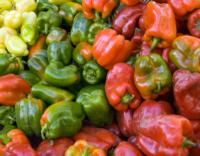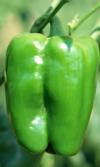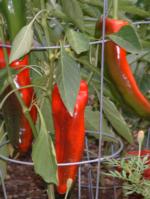Peppers, growing
-
There are a few basic things that peppers need to grow well.

Sun – 6 hours at least, daily. Peppers need a long warm growing season, with daytime temperatures of 75-85°F and night time temperatures between 55-65°F. They grow slowly in cool weather and are frost-sensitive. When daytime temperatures approach 100°F, pollination, fruit set and yield are reduced.
Soil – Will grow in most soils as long as there is good drainage. Unless you have perfect loamy soil, amend soil with compost.
Water – Regular watering to maintain uniform soil moisture at the root zone. Peppers are deep rooted, to about 20 inches deep, so less frequent but deep irrigation is recommended.
Mulch – Apply a mulch to help maintain uniform soil moisture and prevent weeds.
Fertilizer – Mix organic fertilizer into the soil, according to package directions, when planting. No need to fertilize again until blossoms appear, then fertilize lightly if desired every 2-4 weeks until the end of harvest.
Support – Some varieties do benefit from stakes, cages or other support systems.
When to plant
Peppers need a long warm growing season, and prefer daytime temperatures of 75-85°F and night time temperatures between 55-65°F. In cool weather, fruit will not set, develop or ripen. Peppers are frost-sensitive. When daytime temperatures approach 100°F, pollination, fruit set and yield are reduced.If planting seeds directly into the ground, air temperatures should be about 77°F or higher. Seeds can be started 4-6 weeks sooner indoors, and then seedlings transplanted when the weather is warmer. Generally, peppers can be planted from seed and transplants in April – May.
Varieties
There are two types of peppers – the large-fruited mild-flavored bell peppers and the hot varieties.Sweet peppers
The mild peppers include bell, banana, pimiento, sweet cherry.
Bell peppers usually have a blocky appearance, and are commonly harvested when green, although they turn red or yellow when fully ripe. There are more than 200 varieties, including some colored purple and other colors.
Banana peppers are long and tapering and harvested when yellow, orange or red.Pimiento peppers are small, conical, thick-walled. They are usually used when fully ripe, red colored.
Cherry peppers vary in size and flavor, and are harvested when orange to deep red.
Hot peppers
The hot peppers include cayenne, celestial, large cherry, serrano, tabasco, jalapeno.
Hot peppers are usually allowed to ripen fully and change colors (except for jalapenos) and have smaller, longer, thinner and more tapering fruits than sweet peppers. Yields are smaller for hot peppers. Hot peppers that you plan to dry should be allowed to ripen on the plant; they turn red and can be cut from the stem and hung to dry.The hot cayenne pepper group fruits are slim, pointed, and slightly twisted. They can be harvested when they are either green or red. Varieties include Anaheim, cayenne, serrano, jalapeno.
Celestial peppers are small, cone shaped and very hot. They vary in color from yellow to red to purple, and are attractive to grow.
Tabasco peppers are small, slender and pointed. They taste extremely hot and include varieties such as Chili Piquin and Small Red Chili.
Read more about Pepper Varieties.



